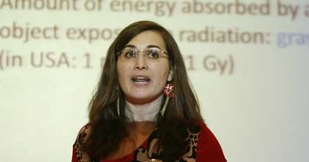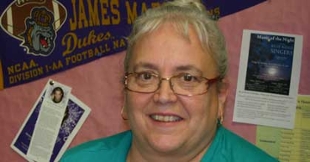Cecilia McGough's Pulsar Discovery
Being the Change
JMU's Saturday Morning Physics provides footing for student's research
By Vanessa Ehrenpreis

For most people the thought of being a 'rocket scientist' would be daunting, but for 17-year-old Cecilia McGough it has simply been a goal. McGough, a senior at Strasburg High School, has taken every possible opportunity to realize her lifelong dream. After years of participating in aerospace camps, physics programs, and engineering classes her crowning achievement came this summer when she discovered a pulsar.
"I was thrilled. We were all super tense—after examining all these data sets it might just come up as noise. I don't think I was ever so happy [as I was in that moment]," McGough said.
A pulsar is a highly magnetized, rotating neutron star that emits a beam of electromagnetic radiation, similar to a natural radio emission—more simply, a dense dying star that rotates. This rotation causes a 'pulse' of light, much like that of a lighthouse. McGough's pulsar, which has a period of 185.549 milliseconds and is about the size of Washington D.C., is only the sixth in the world to be discovered by a student.
Months before McGough made her groundbreaking discovery, she participated in Saturday Morning Physics at JMU. The six-week enrichment program explored the latest discoveries in astronomy and physics. McGough credits SMP with providing the scientific footing necessary to conduct her pulsar research.
"It definitely [prepared me for my research]. SMP answered a lot of questions and such that I had about physics," McGough said. McGough specifically enjoyed the program's lecture about general relativity, a concept that is extremely important in pulsar research. "Pulsars give us a way to test general relativity and it's predictions."

Professor Adriana Banu started SMP in 2010 in an effort to show what students can do with a physics or science degree. The program integrates hands-on activities and lectures conducted by JMU faculty. These activities provide students with "a real college experience."
"I wanted to let students know that they can be scientists and still have a life," Banu said. "SMP is not only about teaching it's also about research. They have access to research—frontline research, and that opens doors."
Motivated and talented students, like McGough, are what Banu describes as the "payoff" for running a program like SMP.
"This payoff is everything. As a young professor it's all researching and teaching. When I hear about these things [McGough's discovery] it's all worth it."
Banu considers McGough among the top ten students at SMP, her innate curiosity about all things science put her a step above her peers.
"She was curious about every topic, not just astronomy. She questions everything that happens. She's thinking about what's going on around her, and that's really important," Banu said.

Dottie Edwards ('01), an astronomy teacher and McGough's mentor at Strasburg High, has long recognized the abilities of her ambitious student. "I started crying when her scan was confirmed," says Edwards. "I understood at that moment what [the pulsar] would mean to her. And that's something she's beginning to figure out now."
McGough, along with four other students at Strasburg High participated in the Pulsar Search Collaboratory this past year.
PSC began in 2008 when the Green Bank Telescope in West Virginia—the world's largest fully steerable telescope—was stuck in one position due to a damaged track. While repairs were being conducted, the telescope continued to collect data. After collecting over 30 terabytes of technically "unwanted" drift scan data, astronomers at West Virginia University decided to use these scans to search for pulsars with the aid of high school students.
The program, now in its fourth year has seen over 200 students from 33 different schools participate.
